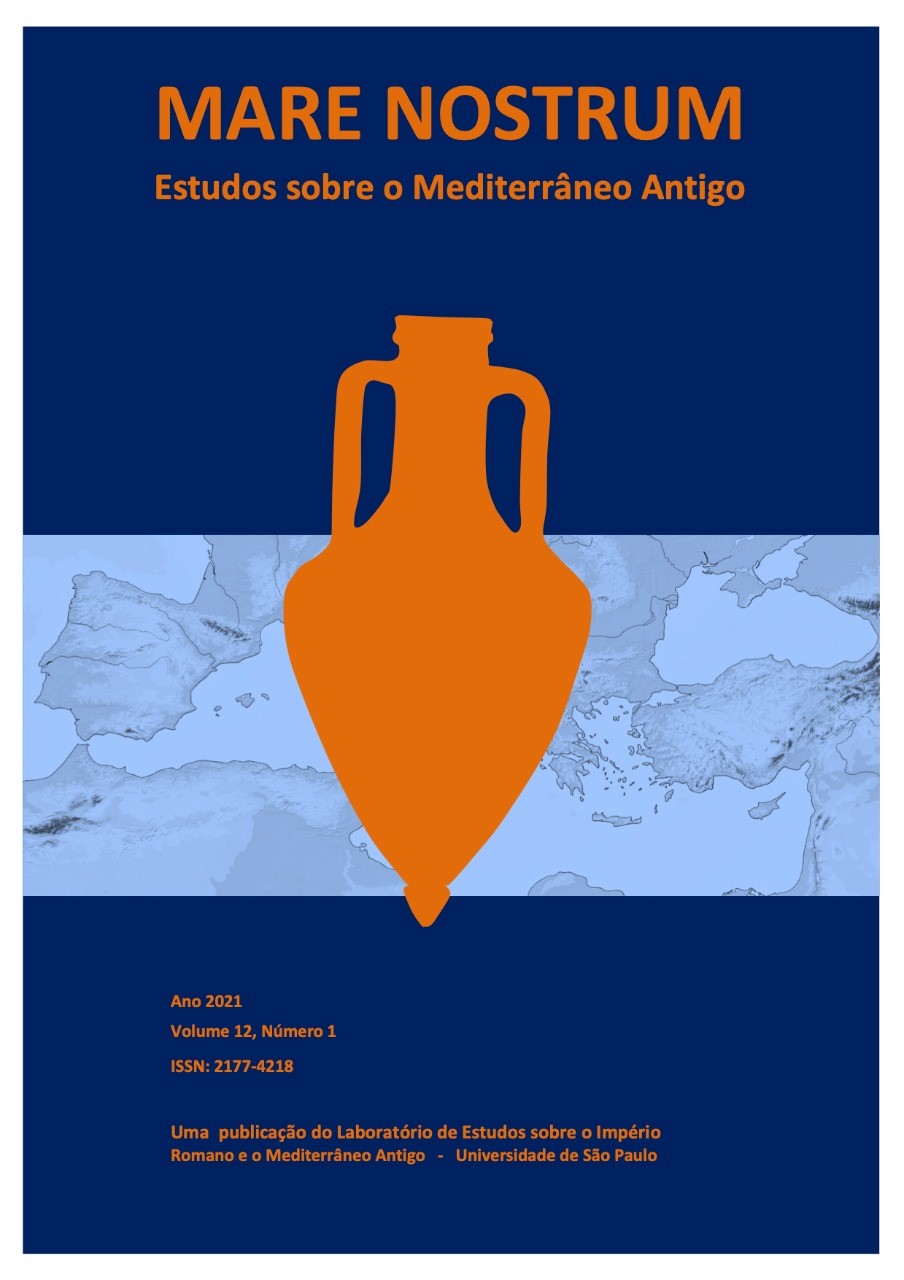Pequeno histórico do ‘matriarcado’ como hipótese para a interpretação da pré-história
DOI:
https://doi.org/10.11606/issn.2177-4218.v12i1p1-25Palavras-chave:
Matriarcado, Pré-história, 'Grande Deusa', Johann BachofenResumo
Neste artigo apresentamos um panorama do desenvolvimento da ideia de matriarcado pré-histórico desde sua formulação pelo classicista Johann Bachofen no século XIX até sua transformação, no século XX, por uma nova ênfase na proposição de uma ‘Grande Deusa’ pré-histórica. Refletimos sobre as ideias de História nela envolvidas, em especial quanto ao contraste entre uma Pré-História dinâmica, complexa e ao longo de sua própria temporalidade eivada de conflitos e transformações, como em Bachofen, e formulações em sentido oposto, encontradas em autoras como Jane Harrison, Jacquetta Hawkes e Marija Gimbutas. Além disso, consideramos as críticas acadêmicas e políticas conduzidas contra a hipótese.
Downloads
Referências
Associação Brasileira do Agronegócio Ribeirão Preto. (2001). Agronegócio – Sua vida depende dele [Cartilha]. Ribeirão Preto, SP, Brasil.
Bachofen, J. J. (1967). Mother Right. In Myth, religion and mother right (seleção de 1926 do original de 1861, pp. 69-207). Bollingen.
Bachofen, J. J. (1967). My life in retrospect. In Myth, religion and mother right (original de 1854, pp. 3-17). Bollingen.
Bebel, A. (1917). Women under Socialism (original de 1884). New York Labor News.
Boff, L. (2018 Fevereiro 16). Como o patriarcado se impôs ao matriarcado há mais de 10 mil anos. O Tempo. https://www.otempo.com.br/opiniao/leonardo-boff/como-o-patriarcado-se-impos-ao-matriarcado-ha-mais-de-10-mil-anos-1.1574660.
Boulos, A. (2015). História, Sociedade e Cidadania, 6o Ano. FTD.
Cabrini, C., Catelli, R., & Montellato, A. (2004). História Temática. Tempos e Culturas. Ensino Fundamental, 5a Série. Scipione.
Cantarella, E. (1981). Pandora’s daughters. Johns Hopkins.
Daflon, E. (2018, Maio 15). A história do agronegócio ou a deformação do passado? [Conferência]. I Jornada sobre Ensino de História Antiga e Medieval, Instituto Federal Fluminense, Macaé, RJ, Brasil.
Daly, M. (1973). Beyond god the father. Beacon Press.
Davies, P. (2010). Myth, Matriarchy and Modernity. De Gruyter.
Davis, E. G. (1971). The first sex. Putnam.
Ehrenberg, M. (1989). Women in Prehistory. British Museum.
Eísler, R. (1987). The Chalice and the Blade. Harper.
Eller, C. (2000). The Myth of Matriarchal Prehistory. Boston: Beacon, 2000.
Eller, C. (2011). Gentlemen and Amazons. Berkeley: California UP, 2011.
Engels, F. (2019). A Origem da Família, da Propriedade Privada e do Estado (4a ed., 1891). Boitempo.
Evans, A. (1895). Cretan Pictographs and Prae-Phoenician script. Bernard Quaritch.
Evans, A. (1899/1900). Knossos. Summary Report of the Excavations in 1900: I. The Palace. The Annual of the British School at Athens, 6, 3-70.
Evans, A. (1930). The Palace of Minos at Knossos (Vol. 3). MacMillan.
Evans, A. (1931). The Earlier Religion of Greece in the light of Cretan Discoveries. Macmillan.
Evans, A. (1936). The Minoan World. Lecture at the Royal Academy of Arts. Oxford UP.
Federici, S. (2015, Abril 21). Entrevista a Gladys Tzul Tzul. El patriarcado del salario. Comunitaria Press. https://comunitariapress.wordpress.com/2015/04/21/el-patriarcado-del-salario-lo-que-llaman-amor-nosotras-lo-llamamos-trabajo-no-pagado/#_ftn1
Fraser, R. Introduction (1994). In FRAZER, James George. The Golden Bough (edição abreviada de 1922). Oxford UP.
Frazer, J. G. (1890). The Golden Bough.
Gage, M. J. (1883). Woman as an Inventor. The North American Review, 136(318) 478-489.
Gamble, E. B. (1894). The Evolution of Woman. G. P. Putmam’s Sons.
Georgeoudi, S. (1994). Creating a Myth of Matriarchy. In SCHMITT-PANTEL, Pauline (ed.), A History of Women in the West. I (original de 1990, pp. 449-463). Harvard UP.
Gimbutas, M. (1989). The Language of the Goddess. Harper & Row.
Gimbutas, M. (1991). The Civilization of the Goddess. Harper & Row.
Gobert, E.-G. (1968). Sur les ‘Vénus Aurignaciennes’. In CENTRE NATIONAL DE LA RECHERCHE SCIENTIFIQUE, La Préhistoire. Problèmes et tendances (pp. 209-221). CNRS.
Guerra, L. (2019). Reflexões sobre os sentidos dos passados distantes. Transversos, 16, 148-166. https://doi.org/10.12957/transversos.2019.44740
Harrison, J. E. (1903). Prolegomena to the study of Greek Religion. Cambridge UP.
Hawkes, J. (1951). A Land. Cresset.
Hawkes, J., & Priestley, J. B. (1955). Journey Down a Rainbow. William Heinemann.
Hawkes, J. (1968). Dawn of the Gods. Random House.
Hodder, I. (2003). Women and men at Çatalhöyük. Scientific American Special Editions, 76-83.
Hodder, I. (2014). Çatalhöyük: the leopard changes its spots. Anatolian Studies, 64, 1-22. https://doi.org/10.1017/S0066154614000027
Hutton, R. (1997). The Neolithic Great Goddess: a study in modern tradition. Antiquity, 71, 91-99. https://doi.org/10.1017/S0003598X0008457X
Keller, M. L. (1997). The interface of Archaeology and Mythology: a philosophical evaluation of the Gimbutas Paradigm. In Marler, J. (ed.). From the realm of the Ancestors: an anthology in honor of Marija Gimbutas (pp. 381-389). Knowledge, Ideas & Trends.
Kergoat, D. (2009). Divisão sexual do trabalho e relações sociais de sexo. In Hirata, H., Laborie, F., Le Doaré, H., Senotier, D. (orgs.). Dicionário Crítico do Feminismo (pp. 67-75) UNESP.
Lerner, G. (2019). A Criação do Patriarcado (original de 1986). Cultrix.
Larsen, C., Knüsel, C., & Haddow, S. (2019). Bioarchaeology of Neolithic Çatalhöyük reveals fundamental transitions in health, mobility, and lifestyle in early farmers. Proceedings of the National Academy of Sciences, 116(26), 12615-12623. https://doi.org/10.1073/pnas.1904345116
Liverani, M. (2016). Antigo Oriente (original da 2a ed., 2009). EdUSP.
Lubbock, J. (1870). The Origin of Civilisation. D. Appleton & Co.
MacGillivray, J. A. (2002). Minotauro. Sir Arthur Evans e a Arqueologia de um mito (original de 2000). Record.
Marx, K. (2015) Apuntes etnológicos. In Escritos sobre la Comunidad Ancestral (original de 1880-1882, pp. 209-221). Fondo Editorial y Archivo Histórico de la Asamblea Legislativa Plurinacional.
Mathieu, N.-C. (2009). Sexo e Gênero. In Hirata, H., Laborie, F., Le Doaré, H., Senotier, D. (orgs.). (2009). Dicionário Crítico do Feminismo (pp. 222-231). UNESP.
McLennan, J. F. (1865). Primitive Marriage. Adam & Charles Black.
Meskell, L. (1998). Oh my Goddess! Archaeological Dialogues, 5(2), 126-142. https://doi.org/10.1017/S1380203800001264
Meskell, L., & Nakamura, C. (2004). Figurines and miniature clay objects. Çatalhöyük 2004 Archive Report. http://www.catalhoyuk.com/archive_reports/2004/ar04_25.html
Meskell, L., & Nakamura, C. (2009). Articulate bodies: forms and figures at Çatalhöyük. Journal of Archaeological Method and Theory, 16, 205-230. https://doi.org/10.1007/s10816-009-9070-3
Meskell, L., & Pearson, J. (2013). Isotopes and Images: Fleshing out Bodies at Çatalhöyük. Journal of Archaeological Method and Theory, 20(3), 1-22. https://doi.org/10.1007/s10816-013-9184-5
Morgan, L. (1877). Ancient Society. Charles Kerr & Co.
Motooka, D., & Barbosa, M. (2014). Para Viver Juntos. História. Ensino Fundamental 6o Ano. SM.
Noble, V. (1991). Shakti Woman. Feeling our fire, healing our world. Harper.
Pembroke, S. (1967) Women in charge: the function of alternatives in Early Greek tradition and the ancient idea of matriarchy. Journal of the Warbrug and Courtauld Institutes, 30, 1967, 1-35. https://doi.org/10.2307/750735
Pilloud, M. & Larsen, C. (2011). ‘‘Official’’ and ‘‘Practical’’ Kin: Inferring Social and Community Structure From Dental Phenotype at Neolithic Çatalhöyük, Turkey. American Journal of Physical Anthropology, 145, 519-530 https://doi.org/10.1002/ajpa.21520
Ribeiro, V., & Anastasia, C. (2015). Piatã História, 6o Ano. Positivo.
Scott, J. (1995). Gênero. Uma categoria útil de análise histórica (original de 1988). Educação e Sociedade, 20(2) 71-99.
Sjöö, M. & Mor, B. (1987). The great cosmic mother. Harper Collins.
Stanton, E. (1891). The Matriarchate or Mother-Age. The National Bulletin, Feb. 1891, 1-12.
Steinem, G. (2013). Wonder Woman. In Hatfield, C., Heer, J., & Worcester, K. (eds). The superhero reader (original de 1972, pp. 203-210). Mississippi UP.
Tylor, E. B. (1896). The Matriarchal Family System. Nineteenth Century, 40, 81–96.
Ucko, P. (1962). The interpretation of the anthropomorphic figurines. Journal of the Royal Anthropologic Institute, 92, 38-54. https://doi.org/10.2307/2844320
Vaz, M. L. & Panazzo, S. (2015). Jornadas.hist: História, 6o Ano. Saraiva.
Vidal-Naquet, P. Escravidão e ginecocracia na tradição, no mito, na utopia. In Vernant, J.-P. Vidal-Naquet, P. Trabalho e Escravidão na Grécia Antiga (original de 1988). Papirus.
Wagner-Hasel, B. (2020). Instead of a Conclusion. Gynaecocracy in the Orient, Oriental Seclusion
in the Occident. In Carlà-Uhink, F. & Wieber, A. (eds.), Orientalism and the Reception of Powerful Women from the Ancient World (pp. 200–209). Bloomsbury Academic
Wagner-Hasel, B. (1991). Le Matriarcat et la Crise de la Modernité. Mètis, 6(1-2), 43-61. https://doi.org/10.3406/metis.1991.961
Downloads
Publicado
Edição
Seção
Licença
Copyright (c) 2021 Lolita Guimarães Guerra

Este trabalho está licenciado sob uma licença Creative Commons Attribution 4.0 International License.
Os conteúdos expressos nos textos publicados pela Mare Nostrum são de exclusiva responsabilidade de seus respectivos autores.
A reprodução dos textos editados pela Mare Nostrum é permitida sob licença Creative Commons, Atribuição-NãoComercial (CC BY-NC).
Autores que publicam nesta revista concordam com os seguintes termos:
- Autores mantém os direitos autorais e concedem à revista o direito de primeira publicação, com o trabalho simultaneamente licenciado sob a Licença Creative Commons Attribution que permite o compartilhamento do trabalho com reconhecimento da autoria e publicação inicial nesta revista.
- Autores têm autorização para assumir contratos adicionais separadamente, para distribuição não-exclusiva da versão do trabalho publicada nesta revista (ex.: publicar em repositório institucional ou como capítulo de livro), com reconhecimento de autoria e publicação inicial nesta revista.
- Autores têm permissão e são estimulados a publicar e distribuir seu trabalho online (ex.: em repositórios institucionais ou na sua página pessoal) a qualquer ponto antes ou durante o processo editorial, já que isso pode gerar alterações produtivas, bem como aumentar o impacto e a citação do trabalho publicado (Veja O Efeito do Acesso Livre).









